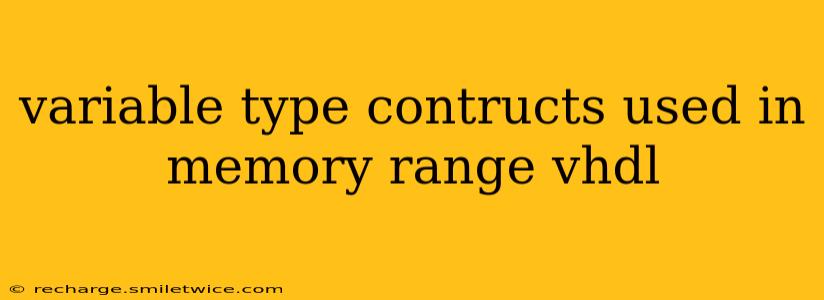VHDL (Very High Speed Integrated Circuit Hardware Description Language) offers several ways to declare and utilize variables within memory ranges, crucial for designing and modeling memory-intensive hardware components. Understanding these constructs is fundamental to efficient and accurate VHDL coding. This article delves into the common variable types and their applications within memory ranges in VHDL.
Understanding Memory Ranges in VHDL
Before exploring variable types, it's essential to grasp the concept of memory ranges in VHDL. Memory is typically represented as an array, where each element corresponds to a specific memory location. The range specifies the bounds of this array, defining the addressable memory locations. For example, type ram_type is array (0 to 1023) of std_logic_vector(7 downto 0); declares a RAM (Random Access Memory) that can store 1024 bytes (each byte represented by an 8-bit std_logic_vector).
Common Variable Types for Memory Ranges
Several VHDL variable types are suitable for working with memory ranges. The choice depends on the specific application and the desired level of abstraction.
1. std_logic_vector
The std_logic_vector type is frequently used to represent data within memory. It's a fundamental type in VHDL, offering flexibility in representing binary data of various widths. For example:
type mem_type is array (0 to 15) of std_logic_vector(31 downto 0);
signal my_memory : mem_type;
This code declares a 16-element memory, where each element is a 32-bit vector. std_logic_vector is ideal for representing data at the bit level, making it suitable for modeling register files, RAM, and other memory structures.
2. integer
The integer type is suitable for addressing memory locations or representing data that doesn't require bit-level manipulation. While less common for directly representing the memory contents, it's valuable for indexing into arrays representing memory:
type mem_type is array (0 to 15) of integer;
signal my_memory : mem_type;
variable addr : integer := 5; -- Address variable
Here, addr can be used to access a specific element in my_memory.
3. signed and unsigned
The signed and unsigned types provide functionalities for arithmetic operations on vectors. They're especially useful when performing calculations on data stored in memory, such as adding or subtracting values.
type mem_type is array (0 to 7) of signed(7 downto 0);
signal my_memory : mem_type;
This declares a memory array where each element is an 8-bit signed integer. This is beneficial when dealing with signed arithmetic operations within memory.
4. User-Defined Types
For more complex data structures within memory, user-defined types are beneficial. This allows for creating customized types that best suit the specific needs of the design.
type data_record is record
value : std_logic_vector(15 downto 0);
valid : std_logic;
end record;
type mem_type is array (0 to 255) of data_record;
signal my_memory : mem_type;
This defines a memory that stores records containing both data and a validity bit.
Addressing Memory Ranges
Efficiently addressing memory locations is critical. Common techniques include:
- Direct addressing: Using an integer variable directly as an index, as shown in the
integerexample above. - Indirect addressing: Using a memory location itself to determine the next memory address to access (common in pointer-like structures).
- Offset addressing: Calculating the memory address by adding an offset to a base address.
Choosing the Right Type
The choice of variable type depends on several factors, including:
- Data representation: Bit-level precision (
std_logic_vector), signed/unsigned integers (signed/unsigned), or complex structures (user-defined types). - Arithmetic operations: Use
signedorunsignedif arithmetic operations are needed on memory contents. - Abstraction level: For high-level modeling, user-defined types provide better abstraction.
By understanding these variable types and addressing techniques, you can effectively model and design complex memory-based hardware systems using VHDL. Remember to choose the type that best suits your specific requirements, balancing efficiency and clarity.
